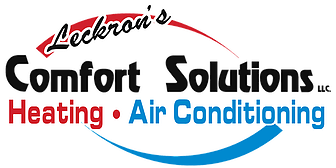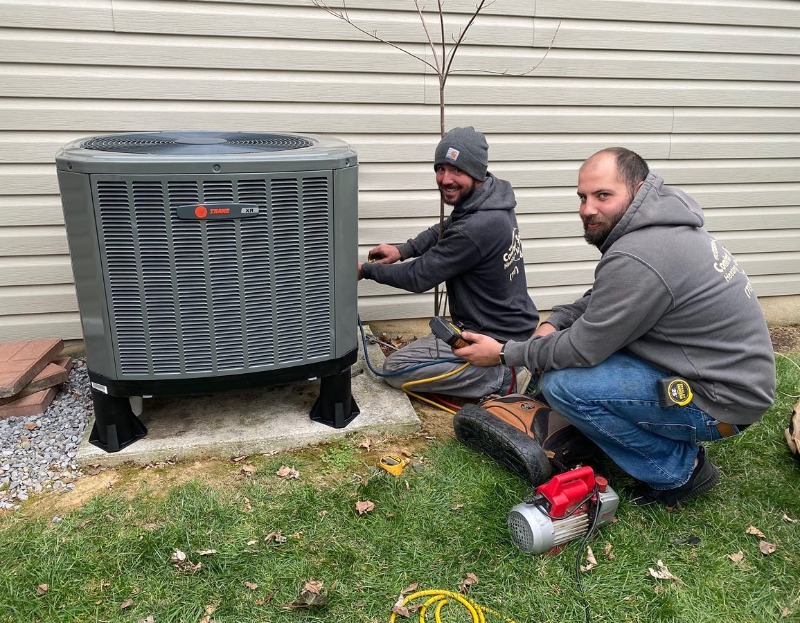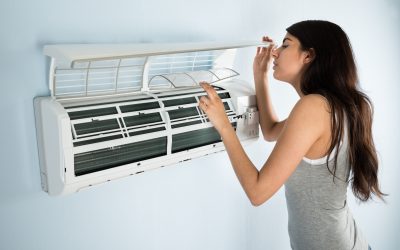The unexpected chilly morning due to a furnace breakdown is one of many issues homeowners risk facing. From a clogged filter to a costly breakdown, there are a plethora of problems that could arise with your HVAC system. When high energy bills, odd smells, strange noises, faulty thermostats, hot and cold spots, or leaking ducts make themselves known, it is time to consider HVAC troubleshooting.
Is it necessary to call your local HVAC company for every issue? Absolutely not. There are many problems you can address and repair on your own. Not only will you save money by fixing minor HVAC issues yourself, but if a situation requires professionals, you can advise them on what you observed. By understanding some issues demand trained technicians, you can get ahead of the problem before it snowballs into a total system replacement.
Expand the life of your system by knowing how to troubleshoot your HVAC unit, when you can fix an issue, and when it’s time to reach out to Leckron’s Comfort Solutions.
Safety Comes First When Troubleshooting Your HVAC System
Because your HVAC system is electrically wired, may use gas and fire, and has many moving parts, you must take safety precautions before troubleshooting.
Consider what you are attempting to troubleshoot. Do you need to consult with a professional first? Is it something that involves refrigerant or the gas line? If so, definitely call Leckron’s for assistance. If it is an easy fix, like an air filter, then go forth and repair it.
The most basic precaution is to shut off the unit. Once you’ve located the power switch or circuit breaker, flip the switch. Grab a voltage tester or multimeter to ensure the electricity is cut to the unit.
Gloves and goggles may be needed for more intense troubleshooting to avoid cutting your hands or having anything enter your eyes. After repairs or troubleshooting, turn the power back on.
Check the Thermostat
Before you tear apart your HVAC unit, see if the problem lies in your thermostat. A thermostat tells your unit to kick on in the first place. If the thermostat registers your air temperature as colder or hotter than it is, your unit won’t kick on effectively.
Overusing your system breaks it down faster due to unnecessary heating and cooling. That’s beyond the uncomfortable temperatures in your home and the risks of mold due to high humidity… not to mention excessive energy bills.
Checking thermostat setting
Ultimately, each thermostat is different in how it must be programmed. The most straightforward advice on programming your thermostat is to refer to the owner’s manual.
Past that, check to see if your thermostat is programmed for the proper configuration. For example, there may be various ways to set it up: furnace versus heat pump.
Furthermore, if you use a set time for the temperature to rise or fall, you may miss other times of the day to save on heating/cooling. Perhaps your thermostat knows to drop the temperature at night, but you don’t have it set up to adjust when you are at work. Check out your settings to see if there are smart settings or the ability to program more than one adjustment during the day. A few moments to program can save money in the long run.
Verify your battery status
After removing your thermostat from the wall, remove the cover and unscrew the compartment housing the batteries. Replace them and see if the thermostat starts operating properly.
Ideally, just like your fire and carbon monoxide detector, you want to change the batteries in your thermostat yearly. Most programmable thermostats have either a light, sound, or reading alerting you when your batteries start failing. If yours does not, assume yearly.
Calibrating or replacing a faulty thermostat
If your thermostat’s temperature reading seems off, it may be time to calibrate your thermostat. Start by letting your HVAC system run for about 15 minutes. What does the thermostat read? What are you measuring? If the readings are off by over a degree, it’s time to calibrate!
Start by checking if the inside of the thermostat is dirty. Remove the cover and use soft clothes or brushes to remove dirt. Do not vacuum the thermostat’s interior in case broken parts are floating around. Furthermore, there can be delicate parts inside the cover. Be gentle.
Some thermostats have mercury vials. Over time, these can move. If your vial is slightly crooked, straighten it back up, being careful not to get any mercury on your skin. Do not force any movement. You risk breaking the vial. If you cannot straighten the vial easily, pause and call for assistance.
Inside the thermostat is a calibration screw generally located behind a curved piece of metal. Use only a screwdriver first to loosen and then re-tighten this screw. While looking at the screw, check out any wires – are they corroded? Do they all still connect as they should?
Test the thermostat again. Let your system run for 15 minutes, and then check the temperature. If the reading is still off, continue troubleshooting.
Inspect the Air Filters
It may appear as if air filters don’t have that big of an impact on your HVAC system, but think again. The filter is responsible for cleaning the air throughout your home. How hard your system has to work to push air through the filter impacts every part of your HVAC system.
When filters become overrun with dirt, debris, and other pollutants, the HVAC unit still must allow the air to flow through the filter and out the other side. The problem is that it takes more effort to do this job. Because the system now has to work harder, the result is a decreased lifespan of your unit with increased component breakdown… all while paying additional on your monthly electric bill.
Inspecting your air filters is a pretty straightforward maintenance item. Locate where your filter is and open the cover. Turn off your HVAC system beforehand so you don’t blow dirty air through your house. Then, pull out the filter. Is it piled up with dirt and debris? If so – replace it! If it barely has accumulation, simply tap it off outside and put it back.
When your filter needs replacing, purchase a filter of the same size and shape. Put in the new filter, paying attention to the arrows indicating which side is up. Replace the cover and turn the machine back on. We recommend changing your filter at least every three months, but if you have animals or a lot of dirt and debris, you may need to do it sooner.
Power Supply
If your unit trips the circuit breaker or turns off, you may have an issue with the power supply. A tripped breaker could indicate that your HVAC unit is using too much electricity for whatever reason. Reset the breaker by going to the box and locating which breaker is flipped in the opposite direction. Then, flip it back. If it flips again, there is an issue with the power supply, and a technician should troubleshoot your unit.
Whether due to a connection issue, wiring problems, or the compressor, pulling in additional electricity to your unit has risks. If your system overheats, it can ruin the internal components, leading to breakdown or system failure. If you notice any issues concerning the power supply to your HVAC operation, call Leckron’s Comfort Solutions for assistance.
Air Vents and Registers
Uneven room temperatures indicate an issue with delivering warmed and cooled air. However, before you worry, consider it may be as simple as a blocked or closed vent.
It is not uncommon for rooms in a home to be unused. Whether it is a storage room or a spare bedroom, most families have rooms minimally used daily. As they sit unoccupied, a natural thought is, “Why should we waste money heating an unused room.” Vents are closed to keep heated or cooled air from going to that particular room.
Unfortunately, when a vent is blocked or closed, airflow problems occur. Your HVAC system is set up with an intentional evaluation of how much air should be distributed to each room to maintain a set temperature. When vents are closed off, more air is pushed to other rooms, affecting the original distribution plan of your ductwork. Consequently, your system is taxed more due to the change in the airflow pattern, leading to early replacement and more repairs.
Before assuming your HVAC system needs massive repair work, check your rooms for closed or obstructed vents. If they are closed, open them back up or remove the obstruction so the airflow in your home returns to its original balanced plan.
Unusual Noises
From booms to rattles to clankity-clanks, noises should not come from your HVAC system. When they do, this indicates something may be wrong. Although a trained HVAC technician will help you avoid misdiagnosing your system, you can get an idea of what the issue could be based on the type of noise you hear.
- Rattling: likely related to the blower’s motor or blades; often indicates something has broken off or is loose. If the banging is loud, shut off the unit immediately and call Leckon’s for help.
- Squealing: squealing is generally one of two things: the fan belt or a motor that needs lubrication. Belts require a technician to replace them, whereas lubrication for a motor can sometimes be done by a homeowner, depending on the make and model.
- Thwap-thwap-thwap: something may be stuck in the blower’s fan blades and wear down the blades.
- Clicking: while it could just be your furnace turning on after a long season off, if it is happening at other times, it could be the compressor, a faulty ignition system, or the air handler. It is best to have a technician diagnose the problem.
- Popping: if the popping comes from your ductwork after turning on your heat, it could simply be the metal expanding. It could indicate a more significant issue if it is located in your unit. Call Leckon’s Comfort Solutions.
- Buzzing: this could be a compressor malfunction or refrigerant leak. Both of these require technicians to fix the problem. If it is a loose part, you may be able to tighten it yourself.
- Booms: if you have a pilot light, the buildup of gas can cause a boom when ignited. If this happens, call your HVAC technician.
- Whistles: if you hear a high-pitched whistle akin to a scream from your AC compressor, cut the power and call a technician. It could be a refrigerant leak, and those with proper training must address the hazardous situation ASAP.
- Rattling: whether the noise is due to the compressor, the compressor’s clutch, or a pulley’s bearings failing – all require a trained technician.
- Hissing: if coming from the AC compressor, it could indicate a refrigerant leak or dangerously high air pressure. If it is from the furnace, it is likely an air duct.
Leaks or Water Issues
Your air conditioning unit should stay dry from leaks. When they happen, it is an indication there is something amiss with the air condition unit. If not caught, water can accumulate, causing mold growth, corrosion, or electrical issues. If your AC unit is upstairs, this water can eventually travel down the floor and walls into the rooms below.
Your unit should have a drain pain located underneath the evaporator coils. Turn on the AC for 20-30 minutes, then inspect for water around the unit. Check the drain pan for cracks and leaks. Turn the unit off and look for the drain pain inside the access panel. Then, check if debris or clogs are in the condensate drain line. Test the drain pain by slowly pouring a gallon of water into the pan. Does it drain freely? If the permanent pan is broken, a technician will need to replace it.
To inspect the condensate drain line, you need first to find it. The indoor air handler has a white PVC pipe that runs from the unit to the outside. Look closely at it for cracks or holes and ensure it runs outside without clogs. Locate the section of the pipe that is vertical and has a cap. Unscrew this cap and slowly pour water into it with a funnel. If it backs up, you have a clog.
Like most HVAC issues, your system overcompensates when the line is clogged or leaks, leading to higher energy bills and quicker breakdowns. Keep an eye on your unit. If you start to see water pooling, address it quickly so a small leak doesn’t turn into a full-on repair.
Monitor System Cycling
Short cycling refers is when a unit turns itself on and off in a short amount of time. Take note of a typical cycle for your home; when it begins to run more often than that, your system could be short cycling.
When your HVAC system, particularly your air conditioner, kicks on and off sooner than it should, it overworks the compressor. Your compressor is attempting to compress and circulate the refrigerant through the unit, and short cycling causes this process to happen more than it should. The additional stress on your HVAC system lowers its lifespan.
What is causing short cycling?
Any number of reasons could cause short cycling. The easiest one to check is your air filters. If they are clogged, the air cannot circulate properly and will trick your HVAC system into thinking it is hotter than it is, prompting it to turn on.
Another reason could be low refrigerant. If your unit doesn’t have enough refrigerant to keep the air cool, it could be forcing it to kick on sooner. Leaking refrigerant is a dangerous situation and needs a technician to help ASAP. Similarly, your system will short cycle if the compressor fails and cannot recirculate the refrigerant effectively.
Incorrect sizing of the furnace to the home disrupts the proper cycling, as does a miscalibrated thermostat. Iced evaporator coils, leaking air ducts, and a failing low-pressure control switch can cause short cycling.
To reduce the risk of your system wearing out too soon, it is imperative that your system cycles as intended. Aside from changing an air filter, a technician should be the one to service most causes of an HVAC system short cycling. If changing the air filter does nothing, call for a maintenance inspection.
Troubleshoot Your Way to Savings
Troubleshooting doesn’t mean that you solve every problem yourself, but rather, you perform an initial evaluation to determine if there are solutions you could solve versus calling for help. There will be some you cannot. Refrigerants, major electrical issues, or compressor failures are prime examples of issues a skilled technician needs to address.
Others, like changing your air filters, calibrating your thermostat, clearing away debris, or replacing your drain pan are not necessarily items a technician must address.
It is imperative when it comes to the inner workings of your HVAC system, electrical or refrigerant fixes, or anything that takes more than tightening a screw, cleaning around the unit, or changing a filter that you don’t try to YouTube a DIY fix. It could not just cost additional repairs if you troubleshoot the wrong thing, but it can also potentially put you and your family in a dangerous situation.
Instead of going down the rabbit hole of Google, give Leckron’s Comfort Solutions a call. We partner with families to provide them with options they feel comfortable choosing. Our goal isn’t to upsell you – it is to provide you with a safe home and faith in knowing your HVAC company wants the best for your family.
Very professional, punctual and most importantly, honest! It’s hard to find good service, but Steven was very knowledgeable and didn’t try to make me pay for things that were unneeded! I’ll definitely use this company again! – Keith R, Customer
When you hear a clank, bang, or hiss, troubleshoot your HVAC system. If it is an easy fix, don’t hesitate to take care of it yourself. But when the problem requires a trained eye, Leckron’s is here for you.




